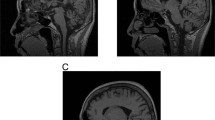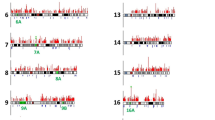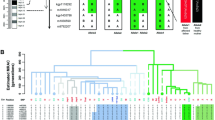Abstract
The causative mutation for spinocerebellar ataxia type 31 (SCA31) is an intronic insertion containing pathogenic pentanucleotide repeats, (TGGAA)n. We examined to what degree the inserted repeats were unstable during transmission. In 14 parent-child pairs, the average change of onset age was −6.4±7.3 years (mean±s.d.) in the child generation when compared with the parent generation. Of the 11 pairs analyzed, six showed expansion of inserted repeat length during transmission, and five showed contraction. On average, the inserted repeats expanded by 12.2±32.7 bp during transmission, but their mean length (with a 95% confidence interval) was not significantly different between parent and child generations. We consider that the length of the inserted repeats in SCA31 is changeable during transmission, but inter-generational instability is not marked, as far as the current sizing method can determine.
Similar content being viewed by others
Main
Spinocerebellar ataxia type 31 (SCA31) (MIM 117210) is one of the most prevalent subtypes of autosomal dominant cerebellar ataxia in Japan.1, 2, 3, 4, 5, 6, 7 Several cross-sectional and prospective studies on Japanese patients have shown that SCA31 is a late-onset, relatively pure cerebellar form of ataxia.1, 2, 3, 4, 5, 6, 7, 8 It is caused by an intronic insertion of pathogenic pentanucleotide repeats, (TGGAA)n, in the BEAN and TK2 genes on chromosome 16q21–q22.9, 10 The length of the insertion varies between patients, ranging from 2.5 to 3.8 kb.7, 9 A weak inverse correlation between the length of the inserted repeats and age at onset has been reported;7, 9 however, little is known about the inter-generational instability of the inserted repeats during transmission. The aim of this study was to assess the genetic instability of the causative mutation during transmission in SCA31. For this purpose, we analyzed inter-generational differences of inserted repeat length and age at onset in parent-child pairs with SCA31.
We collected 17 parent-child pairs from 15 families in this study (32 patients in total, Table 1). We determined age at onset for each patient from their medical records. Nine pairs in eight families showed paternal transmission, while eight pairs in seven families were maternal transmission. Of the 17 parent-child pairs, reliable information on onset age for both generations was available in 14 pairs from 12 families (Table 1). The age at onset was lower in the child generation than in the parent generation (11 pairs, 78.6%) (Table 1). The difference in age at onset ranged from −20 to +7 years in the child generation. When age at onset was compared between the parent and child generations, the difference was statistically significant (P=0.007, paired t-test), indicating a younger age at onset in the child generation. In four pairs, age at onset was considerably lower (>10 years) in the affected child than in the parent. On average, the change of onset age was −6.4±7.3 years (mean±s.d.) in the child generation when compared with the parent generation.
Of the 17 parent-child pairs, genomic DNA was available for 11 pairs from 10 families (21 patients, Table 1). We performed PCR amplification of the fragment encompassing the insertion, purified the PCR product with a QIAquick PCR Purification Kit (QIAGEN, Tokyo, Japan), and digested it with HaeIII, as described previously.7, 9 After HaeIII digestion, one of the authors (AM) randomized and anonymized the samples so that the examiner (KY) was blind to the clinical information of the samples. Gel electrophoresis was performed at a constant 35 V overnight (20 h) and a photograph of the gel was taken with a ruler. The sizing of HaeIII-digested fragments was performed according to an approximate curve (Supplementary Fig. 1), which was drawn based on the migration distance of the molecular size standards from the origin. We sized the fragments five times independently for each patient and calculated the mean and a 95% confidence interval. The mean length of the HaeIII-digested fragment was substituted for that of the inserted repeats. Informed consent for genetic testing was obtained from all study participants.
Representative gel electrogram of HaeIII-digested fragments in eight parent–child pairs is shown in Figure 1. The mean length of the inserted repeats in this cohort (21 patients) is shown in Table 1. In 11 parent–child pairs, the length of the inserted repeats increased in six pairs (five paternal and one maternal) during transmission and decreased in five pairs (three paternal and two maternal). The difference in repeat length in the child generation ranged from −30.9 to +82.5 bp, when compared with the parent generation. On average, the inserted repeats expanded by 12.2±32.7 bp (mean±s.d.) during transmission. This change was within 5–10 repeats, when calculated as the number of pentanucleotide repeats.
Representative gel electrogram of HaeIII-digested fragments. Eight parent-child pairs are shown side by side. The family and patient numbers correspond to those in Table 1 1–12: paternal transmission; 13–16: maternal transmission; M: 1 kb DNA size marker (Nippon Genetics).
The sequence of the inserted repeats in SCA31 is too long and complicated to assess precisely.9 With the current method for analysis, we could not determine the exact size or detailed sequence of the inserted repeats, but their mean length (with a 95% confidence interval) was not significantly different between parent–child pairs. Clinically, it appears as if there is anticipation in onset age in SCA31. Therefore, the relatively younger age at onset in the child generation may be partly due to a bias of awareness of genetic risk. However, the precise effect of (TGGAA)n on disease onset needs to be clarified further.
In total, we analyzed the length of the inserted repeats in 26 patients with SCA31 in this study (Table 1). Of these 26 patients, age at onset was ambiguous in 3 (Patient No. 1, 6 and 14, Table 1). We found no significant correlation between the inserted repeat length and age at onset in 23 patients (Kendall τ Rank Correlation Coefficient: −0.141, P=0.353; Spearman ρ Rank Correlation Coefficient: −0.232, P=0.287) (Figure 2). This was not consistent with our previous observation that there was a weak inverse correlation between inserted repeat length and age of onset in 89 patients from 69 families.7 We consider this is mainly because the present study focused on genetic instability during transmission, and the total numbers of patients and families analyzed were much smaller than our previous study.
SCA31 has a strong founder effect in the Japanese,11, 12 but genetic testing has shown that the maximum difference in inserted repeat length reaches over 1 kb in SCA31 patients.7, 9 Our present data indicate that the inserted repeats in SCA31 are changeable in length during transmission, but that a single transmission may not alter their length so much. Thus, it may take a large number of transmissions to make a significant difference in the inserted repeat length.
The causative mutation for SCA31 is unique among autosomal dominant cerebellar ataxias because it is an intronic insertion of complicated pentanucleotide repeats.9 Among autosomal dominant cerebellar ataxias due to non-coding repeat expansion, it appears that SCA31 shares common features with SCA36, which is caused by a GGCCTG repeat expansion in the first intron of NOP56.13 Both diseases are characterized clinically as late-onset, cerebellar ataxias.1, 2, 3, 4, 5, 6, 7, 8, 13, 14 They have a strong founder effect and distinct ethnic predisposition for the Japanese, although patients genetically confirmed as SCA36 are much smaller in number than those with SCA31 and present with additional features of motor neuron involvement.11, 12, 13, 14, 15 With a remarkable expansion of intronic repeats, it is speculated that an RNA gain-of function mechanism is involved in the pathogenesis of both diseases.10, 13, 16 Interestingly, genetic anticipation is not observed in SCA36.14 It is likely that SCA31 and SCA36 resemble each other in the dynamism of their disease-causing mutations.
In conclusion, we consider that there is no drastic change in the length of the inserted repeats during transmission in SCA31. This may be the molecular basis for the relatively homogeneous clinical phenotype observed in the same family and between families. To our knowledge, our study is the first to examine the inter-generational instability of the inserted repeats during transmission in SCA31 in detail, but it contained only a small number of parent-child pairs; therefore, a nationwide, multicenter collaborative study is desirable to validate our results.
References
Ouyang, Y., Sakoe, K., Shimazaki, H., Namekawa, M., Ogawa, T., Ando, Y. et al. 16q-linked autosomal dominant cerebellar ataxia: a clinical and genetic study. J. Neurol. Sci. 247, 180–186 (2006).
Onodera, Y., Aoki, M., Mizuno, H., Warita, H., Shiga, Y. & Itoyama, Y. Clinical features of chromosome 16q22.1 linked autosomal dominant cerebellar ataxia in Japanese. Neurology 67, 1300–1302 (2006).
Nozaki, H., Ikeuchi, T., Kawakami, A., Kimura, A., Koide, R., Tsuchiya, M. et al. Clinical and genetic characterizations of 16q-linked autosomal dominant spinocerebellar ataxia (AD-SCA) and frequency analysis of AD-SCA in the Japanese population. Mov. Disord. 22, 857–862 (2007).
Basri, R., Yabe, I., Soma, H. & Sasaki, H. Spectrum and prevalence of autosomal dominant spinocerebellar ataxia in Hokkaido, the northern island of Japan: a study of 113 Japanese families. J. Hum. Genet. 52, 848–855 (2007).
Hayashi, M., Adachi, Y., Mori, M., Nakano, T. & Nakashima, K. Clinical and genetic epidemiological study of 16q22.1-linked autosomal dominant cerebellar ataxia in western Japan. Acta Neurol. Scand. 116, 123–127 (2007).
Yoshida, K., Shimizu, Y., Morita, H., Okano, T., Sakai, H., Ohata, T. et al. Severity and progression rate of cerebellar ataxia in 16q-linked autosomal dominant cerebellar ataxia (16q-ADCA) in the endemic Nagano area of Japan. Cerebellum 8, 46–51 (2009).
Sakai, H., Yoshida, K., Shimizu, Y., Morita, H., Ikeda, S. & Matsumoto, N. Analysis of an insertion mutation in a cohort of 94 patients with spinocerebellar ataxia type 31 from Nagano, Japan. Neurogenetics 11, 409–415 (2010).
Nakamura, K., Yoshida, K., Matsushima, A., Shimizu, Y., Sato, S., Yahikozawa, H. et al. Natural history of spinocerebellar ataxia type 31: a 4-year prospective study. Cerebellum 16, 518–524 (2017).
Sato, N., Amino, T., Kobayashi, K., Asakawa, S., Ishiguro, T., Tsunemi, T. et al. Spinocerebellar ataxia type 31 is associated with ‘inserted’ penta-nucleotide repeats containing (TGGAA)n. Am. J. Hum. Genet. 85, 544–557 (2009).
Niimi, Y., Takahashi, M., Sugawara, E., Umeda, S., Obayashi, M., Sato, N. et al. Abnormal RNA structures (RNA foci) containing a penta-nucleotide repeat (UGGAA)n in the Purkinje cell nucleus is associated with spinocerebellar ataxia type 31 pathogenesis. Neuropathology 33, 600–611 (2013).
Li, M., Ishikawa, K., Toru, S., Tomimitsu, H., Takashima, M., Goto, J. et al. Physical map and haplotype analysis of 16q-linked autosomal dominant cerebellar ataxia (ADCA) type III in Japan. J. Hum. Genet. 48, 111–118 (2003).
Ishikawa, K., Toru, S., Tsunemi, T., Li, M., Kobayashi, K., Yokota, T. et al. An autosomal dominant cerebellar ataxia linked to chromosome 16q22.1 is associated with a single-nucleotide substitution in the 5′ untranslated region of the gene encoding a protein with spectrin repeat and Rho guanine-nucleotide exchange-factor domains. Am. J. Hum. Genet. 77, 280–296 (2005).
Kobayashi, H., Abe, K., Matsuura, T., Ikeda, Y., Hitomi, T., Akechi, Y. et al. Expansion of intronic GGCCTG hexanucleotide repeat in NOP56 causes SCA36, a type of spinocerebellar ataxia accompanied by motor neuron involvement. Am. J. Hum. Genet. 89, 121–130 (2011).
Ikeda, Y., Ohta, Y., Kobayashi, H., Okamoto, M., Takamatsu, K., Ota, T. et al. Clinical features of SCA36: a novel spinocerebellar ataxia with motor neuron involvement (Asidan). Neurology 79, 333–341 (2012).
Ishikawa, K., Dürr, A., Klopstock, T., Müller, S., De Toffol, B., Vidailhet, M. et al. Pentanucleotide repeats at the spinocerebellar ataxia type 31 (SCA31) locus in Caucasians. Neurology 77, 1853–1855 (2011).
Liu, W., Ikeda, Y., Hishikawa, N., Yamashita, T., Deguchi, K. & Abe, K. Characteristic RNA foci of the abnormal hexanucleotide GGCCUG repeat expansion in spinocerebellar ataxia type 36 (Asidan). Eur. J. Neurol. 21, 1377–1386 (2014).
Acknowledgements
We would like to thank all the patients who participated in this study. This study was supported from Research Committee of the Ataxia, Research on Policy Planning and Evaluation for Rare and Intractable Diseases, Health and Labour Sciences Research Grants, The Ministry of Health, Labour, and Welfare, Japan (KY).
Author information
Authors and Affiliations
Corresponding author
Ethics declarations
Competing interests
The authors declare no conflict of interest.
Additional information
Supplementary Information accompanies the paper on Journal of Human Genetics website
Supplementary information
Rights and permissions
About this article
Cite this article
Yoshida, K., Matsushima, A. & Nakamura, K. Inter-generational instability of inserted repeats during transmission in spinocerebellar ataxia type 31. J Hum Genet 62, 923–925 (2017). https://doi.org/10.1038/jhg.2017.63
Received:
Revised:
Accepted:
Published:
Issue Date:
DOI: https://doi.org/10.1038/jhg.2017.63





